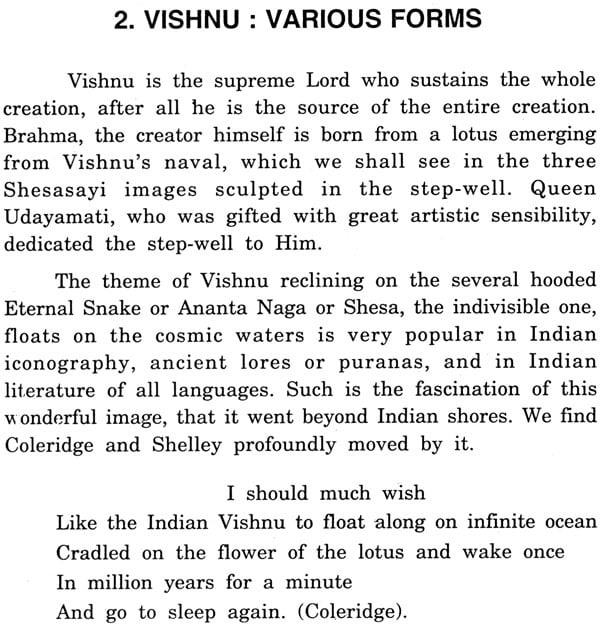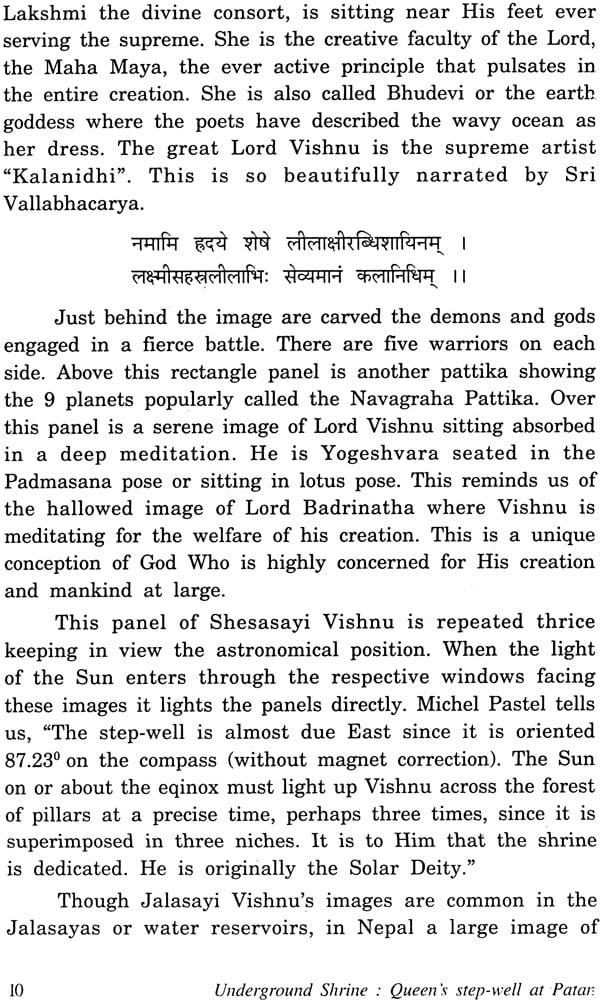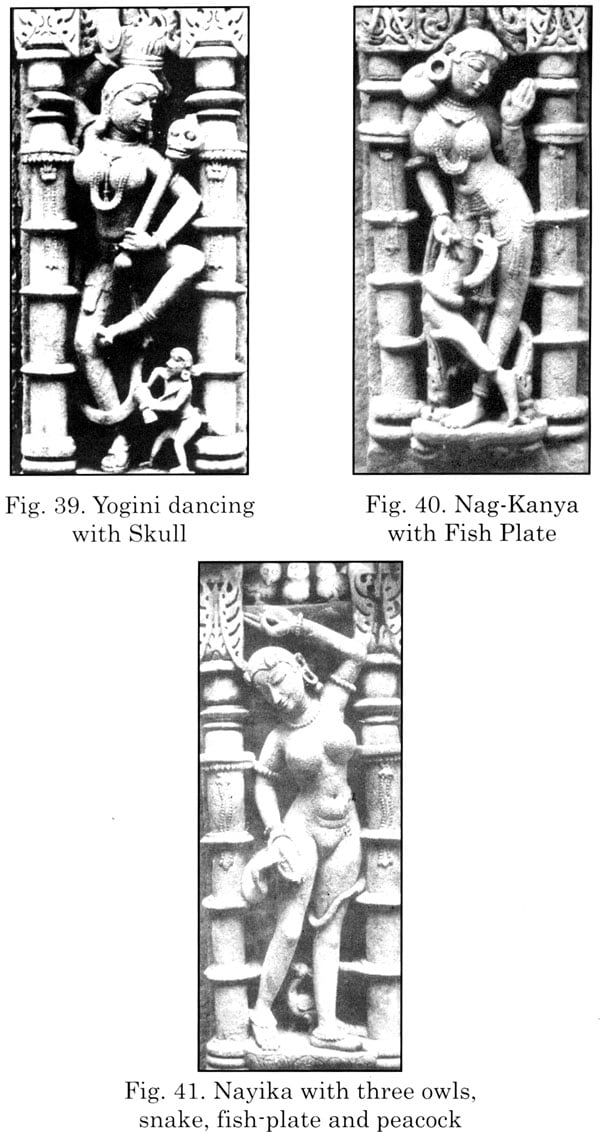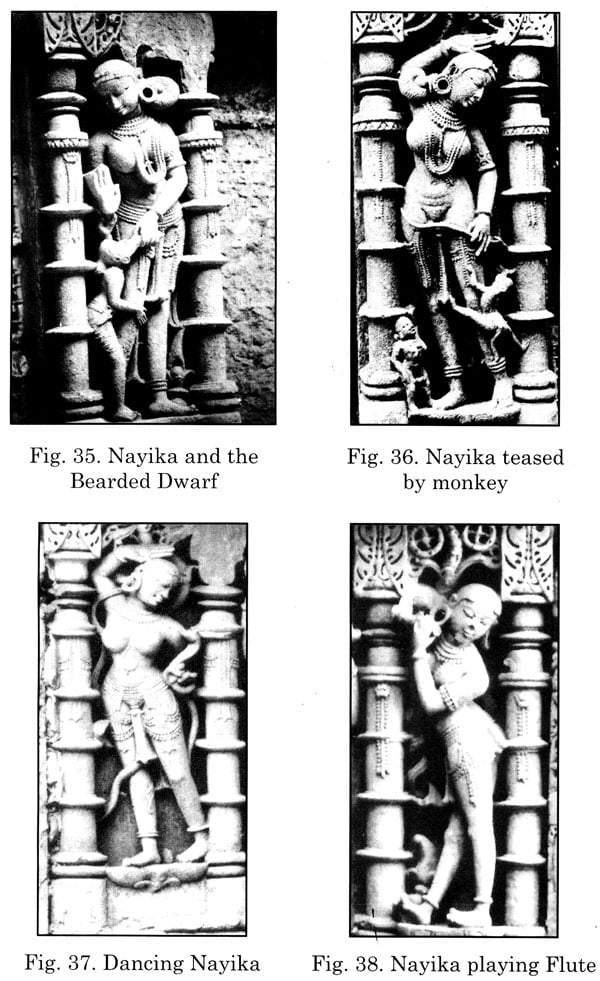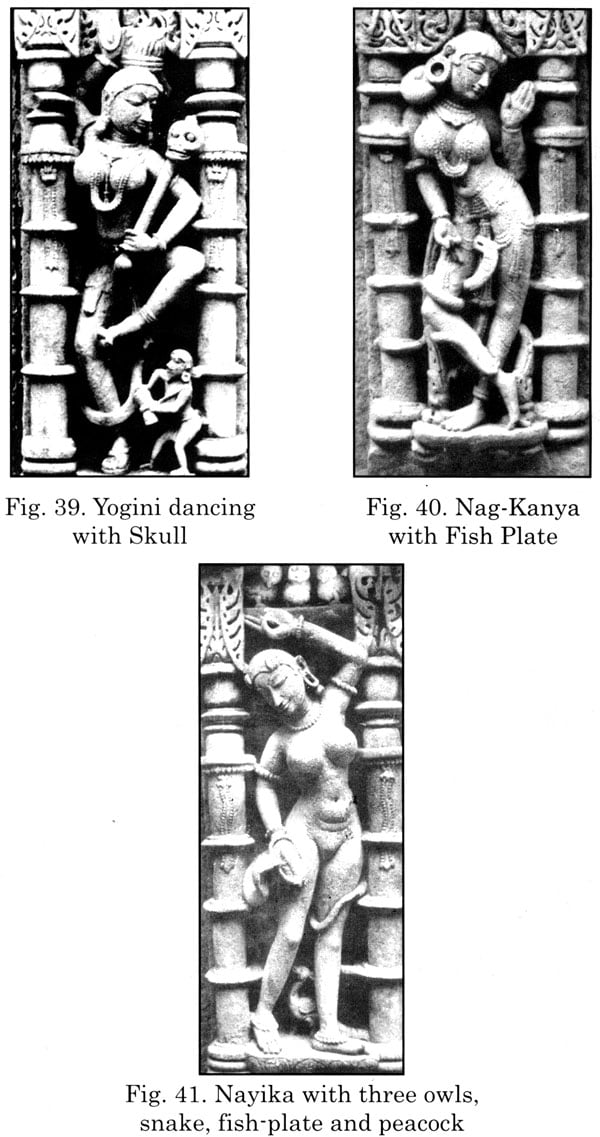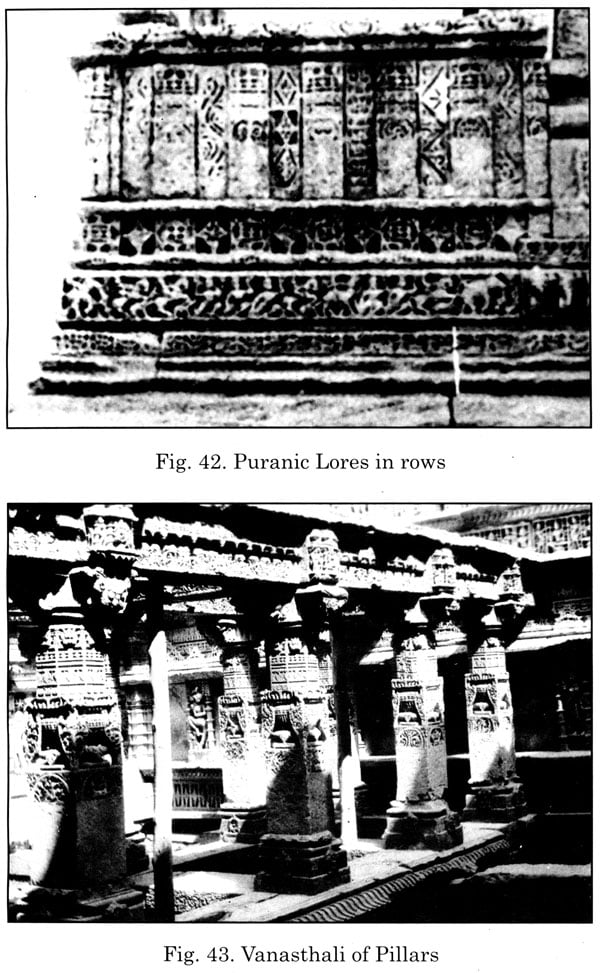
Underground Shrine (Queen's Step-Well At Patan)
Book Specification
| Item Code: | NAF846 |
| Author: | Jaikishandas Sadani |
| Publisher: | Bharatiya Vidya Mandir, Kolkata |
| Language: | English |
| Edition: | 2007 |
| Pages: | 139 (45 B/W Illustrations) |
| Cover: | Hardcover |
| Other Details | 8.5 inch X 5.5 inch |
| Weight | 290 gm |
Book Description
Queen’s step-well at Patan the ancient capital of Gujarat, was built in 1068 A.D. by King Bhimdeva’s Queen Udaimati, a great connoisseur of art and culture. This unique, step-well is seven storeys deep, the like of which is hardly found anywhere in the world. It presents a real panorama of life with all its weals and woes, transcending in a spiritual life of redemption through such magnificent sculptures.
Miss J. Jain, Neubaunes says, “The workmanship of the sculptures display a deep feeling for movement and naturalism.” The sculptures in the panels and niches of Queen’s step-well present over 500 sculpted Puranic episodes and literary lores prevalent in those days. They present a concrete symphony of beauty, full of grace, dignity and charm, which leaves the visitor spellbound. They reveal as it were, the epic poetry inscribed in visual form with delicate emotions of devotion and active dynamic action. They animate the hardness of stone. These sculptures set before us the vast drama of creation through myths, allegories, symbols and the popular lores presented by the superb insight of the ancient masters, leaving for posterity a most enviable and rich heritage of sublime art.
Bharatiya Vidya Mandir, a research Institute is dedicated to popularize and propagate various aspects of Indian Culture, its History, Literature, and Arts. We have published several books of Hindi Epic poems and lyrics translated in English verse by internationally renowned Sri Jaikishandas Sadani. The present monography by him deals with the architectural and sculptural beauty of a remarkable seven storyed step well built in 1068 by the Chaulukya Queen Udaimati a visionary of Art and Culture.
The walls of the stepwell are studded with beautiful sculptures depicting various aspects of Indian Culture through various icons. They portray the religious aspect of Culture along with devotion of the Queen for Indian gods and goddesses.
The step-well remained buried for centuries till it was discovered in 1946 and opened for public view in 1991. Ever since then it has become an attraction for lovers of Art.
Since the sculptures are on walls of the well Shri Sadaniji has named the book as “Underground Shrine.” We are glad to publish the monograph. We are confident it will aptly introduce this precious treasure of art of connoisseurs of Art and tourists and public in general.
It was in September, 1995 that Shri Jaikishandas Sadani delivered three lectures on the various sculptures of the Queen’s step-well at Patan in North Gujarat, under the auspices of Bharatiya Samskriti Series at sheth B. J. Institute of Learning and Research, Ahmadabad. I had the honour to preside over the lectures delivered by Shri Sadani with slides exhibiting various sculptures at the ancient magnificent step-well.
Though Shri Sadani looks after the family business of textiles at Ahmadabad and Calcutta, he has persistently pursued his academic love for literature, philosophy and arts. He has edited some valuable books on Indian paintings, Indian sculptures and performing arts (Music, Dance and Drama). He is actively associated with Bharatiya Samskriti Samsad, Calcutta. He has also contributed a number of important papers on philosophy, literature, arts and culture of India and participated in several seminars on the subjects of his choice. At present Shri Sadani is engaged in editing various volumes of the encyclopedia of Indian Culture.
In Gujarat he is ardently interested in the splendid sculptures of the Queen’s Step-well at Patan, the reputed ancient metropolis of Gujarat. It was the capital of the Capotkata and the Caulukya dynasties as well as the early Sultans of Gujarat. It was renowned for its magnificient monuments like the Queen’s Step-well and the Sahasra-Linga Lake. Its glory declined since 1411 A.D., when the capital of Gujarat got transferred to Ahmedabad. In course of time Patan was reduced to be the headquarter of taluka in Mehsana District and its ancient glorious monuments got buried underground. However, it preserved its reputation for the marvelous textiles known as Patola.
During the 20th century the Archaelogy Department of the erstwhile Baroda State unearthed the ruins of the Sahasralinga Lake and the Archaeological Survey of India recovered the buried splendid Step-well. Recently Patan has been the head quarters of the North Gujarat University and attained the status of headquarters of a District. The ancient magnificent Step-well which remained buried underground for several centuries is recently recovered through archaeological excavations, which have unearthed its seven storeys embellished with splendid sculptures carved by the master artists of the 11th century.
This Step-well was built by Queen Udayamati, wife of King Bhimadeva I (1022-1064 A. D.) She contributed this monument during the reign of her husband, as Merutungacarya alludes to it in the account of Bhimadeva I. Unconscious of the fallacy of anachronism, the author described it as excelling even the Saharsralinga Lake, which was subsequently built by her grandson Jayasimhadeva. Shri Sadani aptly introduces the Queen’s Step-well as an underground shrine, since the magnificent sculptures on the panels and niches in its walls contain figures of various gods and goodesses of the Hindu pantheon along with puranic myths and literary lores. The artists depict the temporal and the spiritual as well as the emotional and the reflective through deites, maidens, saints and animals. In the aesthetic panorama of life depicted in this monument, ‘the artists have brought down the divine on the Earth and raised man to meet the divinity on the Earth’.
The author classifies the deities under the heads of Vishnu, Brahma, Shiva, Shakti and so on. The image of Sesasayi Vishnu, presented here in three panels, is naturally associated with reservoirs. Among the 24 forms of four-armed Vishnu, 15 are recognized here. The author draws our attention to the conspicuous absence of the first two incarnations among the ten major incarnations of Vishnu. Here Shiva figures in a standing as well as a sitting posture, generally along with his consort Uma. Shiva is also depicted in his Kalyanasundara form. In this step-well composite images occur in the forms of Hari-Hara and Hari-Hara-Pitamaha-Arka. Gauri is here depicted in 12 forms. Here the Matrikas are presented in eight forms in place of the usual seven ones. Among other gods and goddesses figure Ganesha, Surya, Indra, Agni, Kubera, Varuna, Bhairava, Hanuman, Sarasvati and Suryani as well as the consorts of the other various gods. The author described the images of these divinites in his first two lectures.
The third lecture was devoted to celestial and human beauties including the varied types of Nayikas and Nagakanyas. The author also makes a passing reference to various narrativs from the Great Epics.
In the concluding section the author has aptly shown how the different Rasas are expressed in the various images depicted here. The author who possesses an aesthetic approach to arts, aptly concludes his book with an aesthetic remark: ‘As we behold the beauty of Queen’s Step-well, we are transported to a realm where eternal beauty floats on the cosmic waters of the well. This grand monument is the sweestest song of Queen Udayamati culminating in cadence of prayers’.
I congratulate Shri Sadani for depicting the various splendid sculptures of the Queen’s Step-well at Patan so vividly and so interestingly. Elucidated through a number of illustrations his depiction supplies a valuable monograph on the splendid sculptures carved on the various parts of the superb ancient monument preserved in the ruins of the metropolis of the Caulukya Period.
The noble and charitable deeds in India were known as Istapurta and thus convention is met with since hoary past. The excavation of a well, tank, canal, construction of water hut, shrine, temple, gate, assembly hall or the consecration of an image and commissioning of a refectory were some of the charitable deeds which have been documented in the inscriptions even in the pre-Christian period. The Queen’s step-well at Patan, Gujarat built by the Caulukyan Queen Udayamati in the 11th century is one of such noble accomplishments. When commenced and completed it aimed at providing fresh water to the public but when this utility was outlived for one reason or the other, it continued to attract the devotees and visitors for its spiritual fervor and artistic grandeur for centuries.
An architectural component or an icon assumes the shape of art if it is chiselled by a skilled and experienced carver but if a piece is handled by a master artist who is blessed, attains the stage of beautiful creation (lalita kala). If such work is appreciated and interpreted by a man of literature the monument becomes immortal.
Such is the case with the Queen’s step-well, the exaulting beauty of which has been lucidly explained by Shri Jaikishandas Sadani who is gifted with a poetic heart beside being a connoisseur of art and literature of high merit. The marvels of the monument have been well lit with the floodlight of his remarkable expressions.
The chance discovery of the step-well with its magnificient repertore of sculptural delineation was the recurrence of the lifting of the beautiful earth goddess by Varaha from the sea as viewed by the great poet Kalidasa in the Raghuvansam (13.8). This may be the reason that the series of incarnations begins from varaha and the earlier two i.e., Matsya and Kurma have been left out for swimming as conceived by Shri Sadani.
Several rare and outstanding iconographic and artistic features of the Step-well have been significantly projected by the writer. The representation of the four armed Buddha wearning a Vaijayantimala suggests that he was given a true divine status of Vishnu in the avatara pattikas. He has further highlighted the fact that despite the depiction of beautiful damsels and nagakanyas the corporal element remains subdued by the divine emotions. This is the summum-bonum of the artistic realm in India (narupam papavrttaye). In earlier well known monuments like Khajuraho and Konark this concept is rather losing the spirit. The description of peacock with the semi-nude Nagakanya has been well explained as the controller of cupid. It is, therefore, quite befitting that the commander-in-chief of the divine army, Karttikeya (also known as Skanda, Subrahmanya, etc.) prefers to have his mount as peacock which is the enemy of Naga representing Kama.
Synthesis is the hallmark of this monument. Although dedicated to Vishnu it vibrates the sentiments of religious harmony. Almost all deities with their family members have been depicted with honour. Aquatic nature (Matsya and Kurma) may suggest that the earth appears with the grace of Lord who lifts it from the depth of the ocean and then commences the divine play (Leela) of creation, protection and annihilation.
The author has given numerous references from the early literature and the canonical treatise while identifying the vast plethora of deities as illustrated on the architectural members of the Step-well. He has further compared them with the examples as available in the museums and the art galleries. This has amply enhanced the research value of this work.
It was a great pleasure to go through the typescript of this book and also to view the beautiful rendering of art through transparencies. I am sure, the dissertation will be welcomed by the scholars and art lovers alike. The author deserves our rich compliments and deep appreciation for giving an excellent treatment to the wonderful art treasures of the Queen;s Step-well.
Queen’s Step-well at Patan, the ancient capital of Gujarat, is a magnificent creation of superb beauty and grace. In it are enshrined the sculptures depicting almost every aspect of Indian culture. The artists have handled the puranic themes and literary heritage with profound depth and understanding, in the language of sculptures.
I visited the remarkable step-well and was thrilled to behold its aesthetic charm and artistic excellence. I discussed about the beautiful images which deck the walls of the step-well with Dr. P. C. Parikh, the then director of B. J. Institute of Learning and Research. He was also highly appreciative of the step-well and proposed to me to give three lectures on the sculptural beauty of Queen’s step-well. I likewise delivered the three lectures in the Institute on 14th, 15th and 16th Sept., 1995 under their series on “Indian Culture”. The book covers the content of the lectures alongwith more details of the other sculptures as well which makes it more fuller and comprehensive. It highlights over 80 sculptures from nearly 500 images. The representative images give a fair idea of the artistic merit and spiritual depiction in Queen Udaymati’s Step-well. Its matchless grandeur is only to be seen to be believed. We are simply enthralled as we behold the images and are lost in the spiritual delight of ecstatic bliss.
I am grateful to the eminent archaeologist and museologist Dr. R. C. Sharma for writing an erudite Foreword and Dr. Hariprasad Shastri for the scholarly prologue. American Institute of Indian Studies, Varanasi has kindly given the required photographs from their archives to enable making the book quite illustrative. I offer my grateful thanks to them.
I am thankful to the publishers for publishing this artistic monograph, and placing it before the connoisseurs of Art. I hope it will aptly communicate the sculptural beauty of Queen Udaimati’s step-well.
Its aesthetic delight will shine all the brighter as years roll on.
Gujarat is rich in its unique cultural heritage. The grand tradition of art, architecture, sculpture and literature has been handed down from generation to generation with amazing continuity. Yet some periods of its history are outstanding epochs in which intense cultural growth and prosperity find their splendid expression.
The period of the Chaulukya or the Solanki dynasty (942 - 1304) with immense cultural contribution has been noted as a very important period in the history of Gujarat. Similar to the Gupta period of Indian history the Chaulukya period has been hailed as the 'Glorious Period' of the history of Gujarat. Along with the attainment of rapid progress and prosperity the cultural growth also has been remarkable and extensive. The Chaulukya rulers not only wielded supreme political power and efficient administration but were benevolent kings, who had great love for arts and literature. During their rule there was significant advancement in this field and we see beautiful temples of rich architecture, imbedded with the splendour of sculptures of rare beauty. The rulers were essentially worshippers of Shiva but had great regard for Vaishnavism, Jainism and other schools of thoughts. This is evidently borne out in the inscriptions of this period.
Mularaja I (942-997) was the founder of the Chaulukya dynasty. He built the temple of 'Muleshvarasvami at Patan, the then capital of Gujarat. He also built the temple of "Mulanarayana" dedicated to Vishnu at Sristhala or Siddhapur. Before he would embark upon any important campaign he would perform worship of Mahalakshmi, the consort of Lord Vishnu. Bhimadeva I, the great grand son of King Mularaja I, ruled Gujarat from 1022-1064. He was a very outstanding ruler imbued with profound religious sensibility. He was a Shaivite in the beginning but later on worshipped Vishnu and Mahalakshmi as well. He had great love for building temples and lakes in their vicinity. He rebuilt the great temple of Somnath after it was ransacked and raised to ground by Mahmud Ghazani. He built the famous Sun Temple of Modhera with beautiful sculptures along with an impressive reservoir nearby.
Bhimadeva I also built the temple of Bhimeshvara and Bhiruani at Patan. He ruled Gujarat for 42 years. King Bhimadeva was a profound devotee of Shiva and Vishnu and Lakshmi as well. He worshipped her beseeching for a son as an heir to his kingdom. He was blessed with a son Karnadeva. Like his illustrious father he continued the cultural tradition and was a great contributory for building outstanding temples. Karnadeva was a Shaivite in the beginning but later on he also worshipped Vishnu and Lakshmi. The copper plates found at Navasari bear the inscription "Om Namo Bhagavate Vasudevaya" - I bow to divine Vasudeva- the incarnation of Vishnu-Lord Krishna. The same plate also has an invocation to Varaha or the Boar avatara of Vishnu. The copper plate was issued by Karnadeva himself in Vikrama Samvat 1131 i.e. in 1074 A. D. The leaning of Chaulukya Kings towards Vaishnavism started by King Mualaraja was taken up both by Bhimadeva I and his son Karnadeva with equal zeal and dedication. The Chaulukya rulers were essentially Shaivites so they naturally built more Shiva temples but their love for Vaishnavism inspired them to build Vishnu-Lakshmi temples as well. This speaks highly of their non-sectarian, universal outlook. They built temples dedicated to Brahma, Vishnu, Shiva, Shakti, Surya, and Ganesha- Vinayaka. Worship of Mahalakshmi was very popular- during Deepavali.
King Bhimadeva's Queen Udayamati, was very generous and ardently religious. Like her husband and son Karnadeva. she herself was a great connoisseur of art and culture and she encouraged her son to build temples, sarovaras and vapis-step-wells. It is stone which is the timeless symbol that lasts the longest in perpetuating the cultural history. It makes the past vividly present for the following generations. No sooner we see the beautiful art creations of the period we are left spell bound, absorbed in prayer. The whole past becomes a living present, thus enabling the unimpeded flow of culture and tradition.
Building of step-wells was for storing water, so that it could be utilised in summer, during that period water scarcity was very common. Thousands of vapis or water reservoirs were built in western India particularly in Gujarat and Rajasthan. Vishnu Dharmottara Purana lays down that "one who digs well for the public, has, as a consequence half his sins absolved when water begins to flow; one who dedicates a pond or vapi is for ever happy and free from thirst. He attains the world of Varuna" (Chaps. 91-92). Thus it was a current practice throughout Gujarat and Rajasthan to build step-wells, wells and lakes or sarovaras to perpetuate the memory of their beloved ones or their forefathers, and for public welfare as well. The step-wells of Gujarat and Rajasthan were 'beautiful monuments of highly specialised structure. Pavilions were built in several storeys.
| Publisher's Note | ||
| Prologue | ||
| Foreword | ||
| Preface | ||
| List of Illustrations | ||
| 1 | Underground Shrine: Introduction | 1 |
| 2 | Vishnu: Various Forms | 8 |
| 3 | Vishnu: Avataras | 14 |
| 4 | Brahma | 24 |
| 5 | Shiva | 26 |
| 6 | Shakti | 36 |
| 7 | Gods and Goddesses | 45 |
| 8 | The Eternal Woman of Grace and Beauty | 59 |
| 9 | Temple of Immortal Bliss | 73 |
